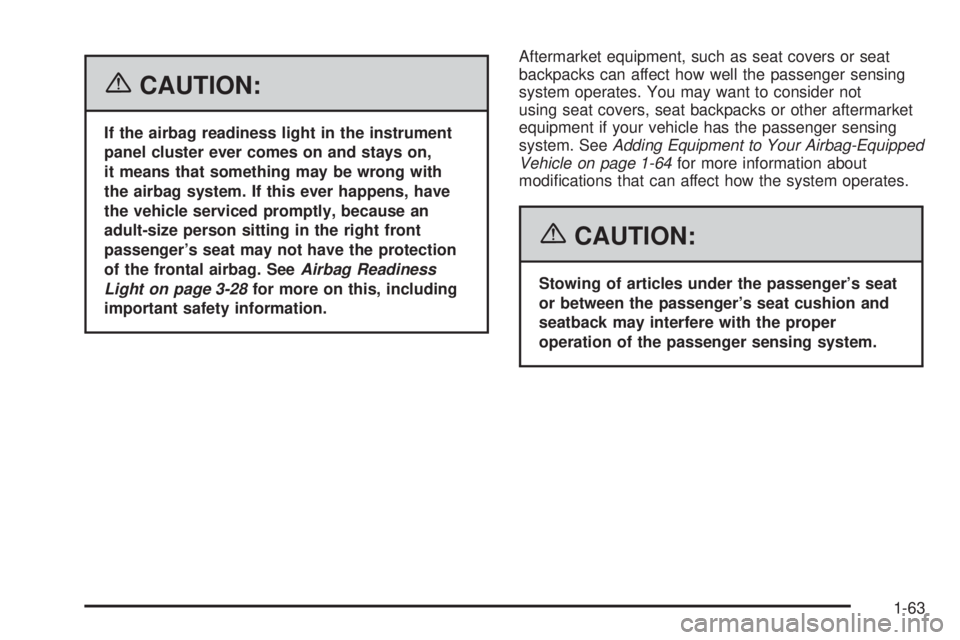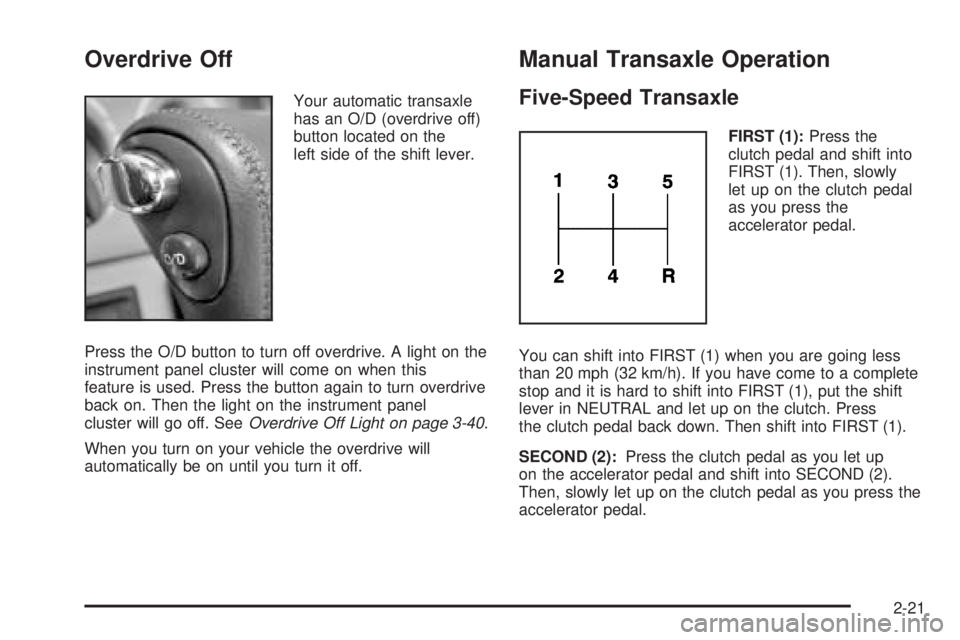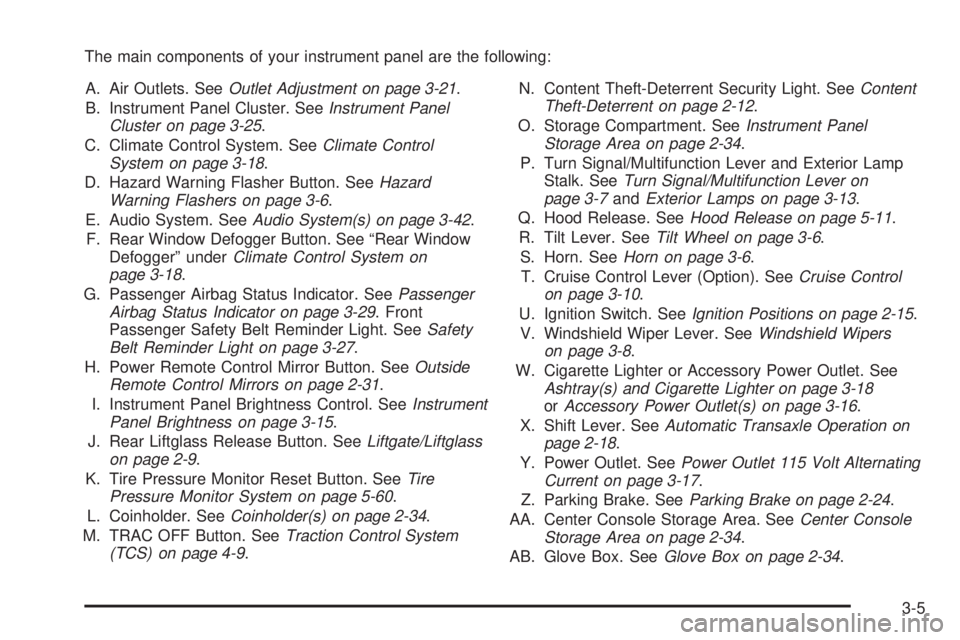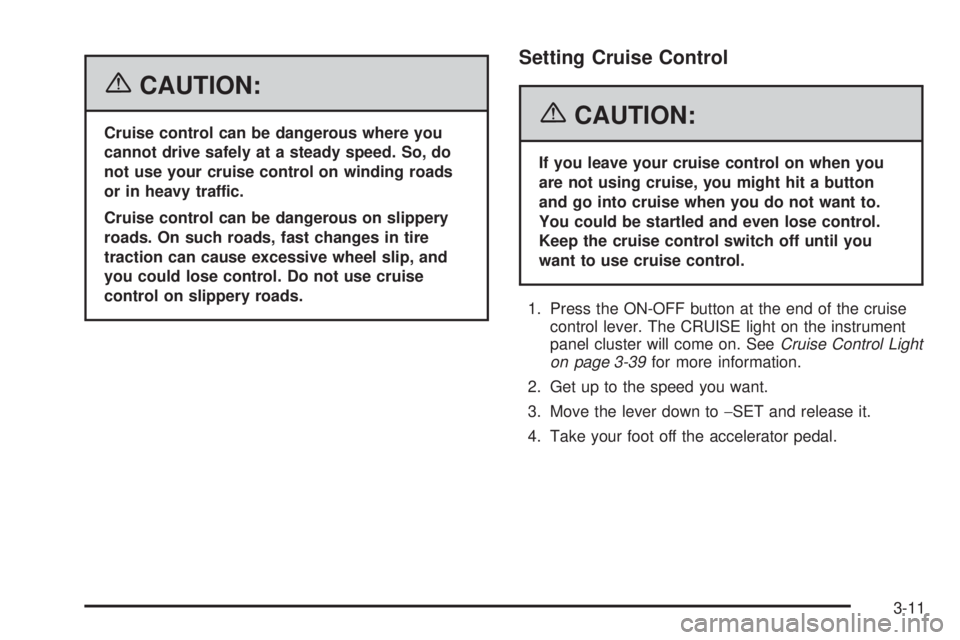instrument cluster PONTIAC VIBE 2006 Owners Manual
[x] Cancel search | Manufacturer: PONTIAC, Model Year: 2006, Model line: VIBE, Model: PONTIAC VIBE 2006Pages: 388, PDF Size: 2.48 MB
Page 69 of 388

{CAUTION:
If the airbag readiness light in the instrument
panel cluster ever comes on and stays on,
it means that something may be wrong with
the airbag system. If this ever happens, have
the vehicle serviced promptly, because an
adult-size person sitting in the right front
passenger’s seat may not have the protection
of the frontal airbag. SeeAirbag Readiness
Light on page 3-28for more on this, including
important safety information.Aftermarket equipment, such as seat covers or seat
backpacks can affect how well the passenger sensing
system operates. You may want to consider not
using seat covers, seat backpacks or other aftermarket
equipment if your vehicle has the passenger sensing
system. SeeAdding Equipment to Your Airbag-Equipped
Vehicle on page 1-64for more information about
modi�cations that can affect how the system operates.
{CAUTION:
Stowing of articles under the passenger’s seat
or between the passenger’s seat cushion and
seatback may interfere with the proper
operation of the passenger sensing system.
1-63
Page 95 of 388

Overdrive Off
Your automatic transaxle
has an O/D (overdrive off)
button located on the
left side of the shift lever.
Press the O/D button to turn off overdrive. A light on the
instrument panel cluster will come on when this
feature is used. Press the button again to turn overdrive
back on. Then the light on the instrument panel
cluster will go off. SeeOverdrive Off Light on page 3-40.
When you turn on your vehicle the overdrive will
automatically be on until you turn it off.
Manual Transaxle Operation
Five-Speed Transaxle
FIRST (1):Press the
clutch pedal and shift into
FIRST (1). Then, slowly
let up on the clutch pedal
as you press the
accelerator pedal.
You can shift into FIRST (1) when you are going less
than 20 mph (32 km/h). If you have come to a complete
stop and it is hard to shift into FIRST (1), put the shift
lever in NEUTRAL and let up on the clutch. Press
the clutch pedal back down. Then shift into FIRST (1).
SECOND (2):Press the clutch pedal as you let up
on the accelerator pedal and shift into SECOND (2).
Then, slowly let up on the clutch pedal as you press the
accelerator pedal.
2-21
Page 113 of 388

Instrument Panel Overview...............................3-4
Hazard Warning Flashers................................3-6
Other Warning Devices...................................3-6
Horn.............................................................3-6
Tilt Wheel.....................................................3-6
Turn Signal/Multifunction Lever.........................3-7
Turn and Lane-Change Signals........................3-7
Headlamp High/Low-Beam Changer..................3-8
Flash-to-Pass.................................................3-8
Windshield Wipers..........................................3-8
Windshield Washer.........................................3-9
Rear Window Wiper/Washer...........................3-10
Cruise Control..............................................3-10
Exterior Lamps.............................................3-13
Headlamps on Reminder................................3-14
Daytime Running Lamps (DRL).......................3-14
Automatic Headlamp System..........................3-14
Fog Lamps..................................................3-15
Instrument Panel Brightness...........................3-15
Interior Lamps Control...................................3-15
Entry Lighting...............................................3-16
Reading Lamps............................................3-16
Accessory Power Outlet(s).............................3-16
Power Outlet 115 Volt Alternating Current........3-17
Ashtray(s) and Cigarette Lighter......................3-18Climate Controls............................................3-18
Climate Control System.................................3-18
Outlet Adjustment.........................................3-21
Passenger Compartment Air Filter...................3-22
Warning Lights, Gages, and Indicators............3-24
Instrument Panel Cluster................................3-25
Speedometer and Odometer...........................3-26
Trip Odometers............................................3-26
Tachometer.................................................3-27
Safety Belt Reminder Light.............................3-27
Airbag Readiness Light..................................3-28
Passenger Airbag Status Indicator...................3-29
Charging System Light..................................3-31
Brake System Warning Light..........................3-32
Anti-Lock Brake System Warning Light.............3-33
Low Tire Pressure Warning Light....................3-33
Traction Control System (TCS)
Warning Light...........................................3-34
StabiliTrak
®Indicator Light..............................3-34
Engine Coolant Temperature Gage..................3-35
Malfunction Indicator Lamp.............................3-35
Oil Pressure Light.........................................3-38
Lights On Reminder......................................3-39
Taillamp Indicator Light..................................3-39
Cruise Control Light......................................3-39
Section 3 Instrument Panel
3-1
Page 117 of 388

The main components of your instrument panel are the following:
A. Air Outlets. SeeOutlet Adjustment on page 3-21.
B. Instrument Panel Cluster. SeeInstrument Panel
Cluster on page 3-25.
C. Climate Control System. SeeClimate Control
System on page 3-18.
D. Hazard Warning Flasher Button. SeeHazard
Warning Flashers on page 3-6.
E. Audio System. SeeAudio System(s) on page 3-42.
F. Rear Window Defogger Button. See “Rear Window
Defogger” underClimate Control System on
page 3-18.
G. Passenger Airbag Status Indicator. SeePassenger
Airbag Status Indicator on page 3-29. Front
Passenger Safety Belt Reminder Light. SeeSafety
Belt Reminder Light on page 3-27.
H. Power Remote Control Mirror Button. SeeOutside
Remote Control Mirrors on page 2-31.
I. Instrument Panel Brightness Control. SeeInstrument
Panel Brightness on page 3-15.
J. Rear Liftglass Release Button. SeeLiftgate/Liftglass
on page 2-9.
K. Tire Pressure Monitor Reset Button. SeeTire
Pressure Monitor System on page 5-60.
L. Coinholder. SeeCoinholder(s) on page 2-34.
M. TRAC OFF Button. SeeTraction Control System
(TCS) on page 4-9.N. Content Theft-Deterrent Security Light. SeeContent
Theft-Deterrent on page 2-12.
O. Storage Compartment. SeeInstrument Panel
Storage Area on page 2-34.
P. Turn Signal/Multifunction Lever and Exterior Lamp
Stalk. SeeTurn Signal/Multifunction Lever on
page 3-7andExterior Lamps on page 3-13.
Q. Hood Release. SeeHood Release on page 5-11.
R. Tilt Lever. SeeTilt Wheel on page 3-6.
S. Horn. SeeHorn on page 3-6.
T. Cruise Control Lever (Option). SeeCruise Control
on page 3-10.
U. Ignition Switch. SeeIgnition Positions on page 2-15.
V. Windshield Wiper Lever. SeeWindshield Wipers
on page 3-8.
W. Cigarette Lighter or Accessory Power Outlet. See
Ashtray(s) and Cigarette Lighter on page 3-18
orAccessory Power Outlet(s) on page 3-16.
X. Shift Lever. SeeAutomatic Transaxle Operation on
page 2-18.
Y. Power Outlet. SeePower Outlet 115 Volt Alternating
Current on page 3-17.
Z. Parking Brake. SeeParking Brake on page 2-24.
AA. Center Console Storage Area. SeeCenter Console
Storage Area on page 2-34.
AB. Glove Box. SeeGlove Box on page 2-34.
3-5
Page 119 of 388

Turn Signal/Multifunction Lever
The turn signal/multifunction lever is located on the left
side of the steering column.
This lever operates the following:
Exterior Lamps. SeeExterior Lamps on page 3-13.
Turn and Lane-Change Signals. SeeTurn and
Lane-Change Signals on page 3-7.
Headlamp High/Low-Beam Changer. SeeHeadlamp
High/Low-Beam Changer on page 3-8.
Flash-to-Pass. SeeFlash-to-Pass on page 3-8.
Fog Lamps. SeeFog Lamps on page 3-15.
Turn and Lane-Change Signals
The turn signal has an upward (for right) and a
downward (for left) position. These positions allow you
to signal a turn or a lane change.
To signal a turn, move the lever all the way up or down.
When the turn is �nished, the lever will return
automatically.
To signal a lane change, raise or lower the lever until
the arrow starts to �ash. Hold it there until you complete
your lane change. The lever will return by itself when
you release it.
An arrow on the instrument
panel cluster will �ash in
the direction of the
turn or lane change.
If you signal a turn or a lane change and notice the
arrow �ashing rapidly, a signal bulb may be burned out
and other drivers won’t see your turn signal.
If a bulb is burned out, have it replaced to help avoid an
accident. If the arrows don’t go on at all when you
signal a turn, check for burned-out bulbs and then check
the fuse. SeeFuses and Circuit Breakers on page 5-91.
3-7
Page 120 of 388

Headlamp High/Low-Beam Changer
The headlamps must be on for this feature to work.
For high beams, push the turn signal lever away
from you.
When the high beams are
on, this light on the
instrument panel cluster
also will be on.
It will go off when you switch to the low beams. To
switch back to low beams, pull the lever toward you.
Flash-to-Pass
With the lever in the low-beam position, pull the lever
toward you to momentarily switch to high beams
(to signal that you are going to pass). If you have the
headlamps on when you release the lever, they will
return to the low beams.
Windshield Wipers
The lever on the right side of the steering column
controls the windshield wipers and washer.
The available positions are the following:
MIST:For a single wiping cycle, move the lever to
MIST. Hold it there until the wipers start, then let go. The
wipers will stop after one wipe.
OFF:The wipers are off.
3-8
Page 123 of 388

{CAUTION:
Cruise control can be dangerous where you
cannot drive safely at a steady speed. So, do
not use your cruise control on winding roads
or in heavy traffic.
Cruise control can be dangerous on slippery
roads. On such roads, fast changes in tire
traction can cause excessive wheel slip, and
you could lose control. Do not use cruise
control on slippery roads.
Setting Cruise Control
{CAUTION:
If you leave your cruise control on when you
are not using cruise, you might hit a button
and go into cruise when you do not want to.
You could be startled and even lose control.
Keep the cruise control switch off until you
want to use cruise control.
1. Press the ON-OFF button at the end of the cruise
control lever. The CRUISE light on the instrument
panel cluster will come on. SeeCruise Control Light
on page 3-39for more information.
2. Get up to the speed you want.
3. Move the lever down to−SET and release it.
4. Take your foot off the accelerator pedal.
3-11
Page 125 of 388

Ending Cruise Control
There are several ways to turn off the cruise control:
Step lightly on the brake pedal or push the
clutch pedal, if you have a manual transaxle.
Press the ON-OFF button again.
Pull the cruise control lever toward you.
Erasing Speed Memory
When you turn off the cruise control or the ignition, your
cruise control set speed memory is erased.
Exterior Lamps
The lever on the left side of the steering column
operates the exterior lamps.
O(Exterior Lamps):Turn the outside part of the
lever with the symbol on it, to operate the lamps. For
vehicles sold in the U. S., this symbol will appear on the
instrument panel cluster when your exterior lamps are on.
The exterior lamp switch has three positions:
OFF:Turning the switch to this position turns off all
lamps, except the Daytime Running Lamps (DRL).
O(Parking Lamps):Turning the switch to this position
turns on the parking lamps together with the following:
Sidemarker Lamps
Taillamps
License Plate Lamp
Instrument Panel Lights
A symbol will appear on the instrument panel cluster
when your parking lamps are on. SeeLights On
Reminder on page 3-39andTaillamp Indicator Light on
page 3-39for additional information.
3(Headlamps):Turning the switch to this position
turns on the headlamps, together with the previously
listed lamps and lights.
3-13
Page 126 of 388

Headlamps on Reminder
If you turn the ignition to LOCK or ACC and leave
the lamps on, you’ll hear a tone when you open the
driver’s door.
Daytime Running Lamps (DRL)
Daytime Running Lamps (DRL) can make it easier for
others to see the front of your vehicle during the
day. DRL can be helpful in many different driving
conditions, but they can be especially helpful in the short
periods after dawn and before sunset. Fully functional
daytime running lamps are required on all vehicles
�rst sold in Canada.
The DRL system will make your headlamps come on at
a reduced brightness when the following conditions
are met:
The ignition is on with the engine running.
The exterior lamps switch is off.
The parking brake is released.
When the DRL are on, only your headlamps will be on
at a reduced brightness. The taillamps, sidemarker
and other lamps won’t be on. Your instrument panel
won’t be lit up either.
When you turn the exterior lamp switch to the headlamp
position, your DRL will go off and your headlamps will
come on. The other lamps that come on with your
headlamps will also come on.When it begins to get dark, the headlamps will
automatically switch from DRL to the regular headlamps.
See “Automatic Headlamp System” following.
When you turn the exterior lamp switch off, the regular
lamps will go off and your headlamps will change to
the reduced brightness of DRL provided it is not
dark outside. DRL also comes on if only the parking
lamps are being used.
Automatic Headlamp System
Your vehicle is equipped with an automatic light sensor
on the top left corner of the instrument panel, so be sure it
is not covered or the headlamps will be on continuously.
When it is dark enough outside, your automatic
headlamp system will turn on your low-beam headlamps
at the normal brightness along with other lamps such
as the taillamps, sidemarker, parking lamps and
instrument panel lights. This is indicated by the
headlamp symbol on your instrument panel cluster. See
Instrument Panel Cluster on page 3-25.
If you are driving through a parking garage, overcast
weather, or a tunnel, the automatic headlamp system
may turn on your low-beam headlamps at a normal
brightness along with the taillamps, sidemarker, parking
lamps and the instrument panel lights. The radio
lights will be dimmer, and the instrument panel cluster
lights may dim. There will be a delay before the
lights will turn on when starting the car at night.
3-14
Page 137 of 388

Instrument Panel Cluster
Your instrument panel is designed to let you know at a glance how your vehicle is running. You’ll know how fast
you’re going, how much fuel is left in the tank and many other things you’ll need to drive safely and economically.
United States Cluster shown, Canada similar
3-25